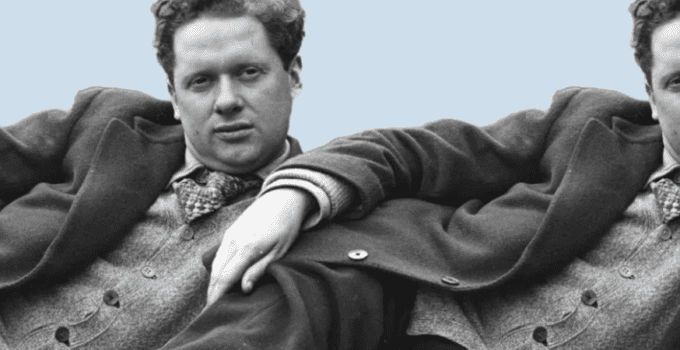Dylan Thomas is a dominant figure in modern Welsh poetry, casting a large shadow over any Welsh poet attempting to be modern. Harold Bloom’s theory of « The Anxiety of Influence » suggests that poets have always been influenced by their predecessors, with the best modern poets turning this inferiority complex into an asset. Dylan Thomas remains a towering presence in Welsh literature, with his insights and music resonating with many. His avant-garde style and comedic genius make him a unique figure in the world of poetry.
In a letter to the American poet John F. Nims, Dylan Thomas humorously describes himself as a « bulging Apple among poets, » showcasing his wit and self-awareness. Despite his public image as a bon viveur, Dylan’s words were beautiful and captivating. His poem « Fern Hill » paints a nostalgic picture of his childhood summers on a farm in Carmarthenshire, highlighting the joy and entitlement of a carefree youth.
The significance of Dylan Thomas’s work lies not only in its meaning but also in its melodic sound and poetic craftsmanship. Sound is just as crucial to meaning as the actual definition of words or phrases. The poem « Fern Hill » by Dylan Thomas showcases a unique rhythm that sets it apart from others. With its abundance of muted syllables, the poem takes on a playful and lively pace. Each line in the poem has its own distinct rhythm, creating a dynamic and engaging reading experience.
Despite the subtle variations in rhythm, Dylan follows a strict syllable pattern in each stanza of the poem. This arrangement defies the traditional iambic pentameter found in English verse, showcasing his rebellious and innovative approach to poetry. The poem’s structure is akin to Welsh jazz, combining technical skill with a casual flair that mirrors the music of Duke Ellington and John Coltrane.
Dylan pays close attention to the sounds within the poem, creating a rich tapestry of vowels and consonants that enhance the overall experience. Through the use of assonance and repeated key words, he weaves a sonic display that captivates the reader. His dedication to crafting the perfect poem is evident in the numerous drafts he went through to refine « Fern Hill. »
Originally published in the literary magazine « Horizon, » « Fern Hill » gained widespread recognition when it appeared in Dylan’s collection « Deaths and Entrances. » The poem is often seen as an elegy to childhood innocence amidst the turmoil of war. Dylan’s firsthand experiences during the war, including his time writing propaganda scripts for the Ministry of Information, influenced his poetic themes and style.
His radio broadcasts on BBC during the war years allowed him to connect with a wider audience and showcase his talents as a writer and speaker. This platform would later lead to the creation of his iconic radio drama « Under Milk Wood, » a testament to his ability to captivate listeners with his language and storytelling.
Before delving into fictional worlds like Llareggub, Dylan focused on capturing the essence of his real-life surroundings in Wales. His deep connection to Swansea and the surrounding areas inspired several radio talks and poems that celebrated the beauty and complexity of his homeland. Among these broadcasts that look back on the past, « Reminiscences of Childhood » has become the most well-known, largely due to the following sentence:
« I was born in a large Welsh industrial town at the beginning of the Great War: an ugly, lovely town (or so it was, and is, to me), crawling, sprawling, slummed, unplanned, jerry-villa’d, and smug-suburbed by the side of a long and splendid-curving shore where truant boys and sandfield boys and old anonymous men, in the tatters and hangovers of a hundred charity suits, beachcombed, idled, and paddled, watched the dock-bound boats, threw stones into the sea for the barking, outcast dogs, and, on Saturday summer afternoons, listened to the militant music of salvation and hell-fire preached from a soap-box. »
The phrase « ugly, lovely town » stands out as the highlight, a motto of reverse-pride that can now be found on landmarks in Swansea. It captures both the harshness and beauty of the place, while also playing with the sounds of the words. This assonance reveals the intertwined nature of ugliness and beauty in Wales, where industrial grays contrast with lush greens and picturesque shores. This linguistic play is not just decorative in Dylan’s verse, but shapes the very essence of his thoughts.
My feelings towards Dylan are complex, as much of his poetry leaves me indifferent. His work, rich in symbols and metaphors, can sometimes feel dry and lacking in vitality. The intensity of his words can overwhelm, resembling the relentless energy of industrial techno rather than the smooth rhythm of jazz. This complexity is evident in poems like « Altarwise by Owl-Light, » where abstract imagery and dense language make it challenging to fully grasp his intent.
Dylan’s story is one of immense talent, scandal, eccentricity, technological advancements, and excellence thriving in plain sight. Despite his popularity, he faced criticism and condescension during his lifetime, being labeled as an ‘impostor’ by some. His Welsh background and self-taught literary skills made him a novelty in the literary world, drawing both admiration and disdain from critics.
The circumstances surrounding Dylan’s death in 1953 have been mythologized, with stories of his final words and drinking habits becoming legendary. While the exact details remain unclear, it is evident that Dylan faced health issues and personal struggles towards the end of his life. Despite his untimely death, Dylan’s legacy as a poet and cultural icon continues to resonate with audiences today. L’écrivain américain Kenneth Rexroth a résumé tout le charme de Dylan en l’eulogisant aux côtés d’un autre génie tragique qui s’est consumé au milieu des années 1950. Comparé aux Piliers d’Hercule, Dylan Thomas se tient aux côtés du saxophoniste Charlie Parker, comme deux Titans ruinés gardant l’entrée d’un des cercles de Dante. Parker était un visionnaire et un styliste musical intransigeant qui a été à l’origine du style de jazz expérimental d’après-guerre connu sous le nom de bebop. Toxicomane, il avait un rapport avec la drogue d’une toute autre ampleur que Dylan. Cette comparaison atténue la rage et l’aliénation de Parker, une grande partie étant due à la préjugé racial, tout en embellissant Dylan avec une réputation de jeune rebelle qu’il mérite seulement à moitié.
### La Célébrité Ambiguë de Dylan
Ce legs controversé s’est avéré être paradoxalement la garantie de la célébrité continue de Dylan. À ce jour, il reste l’un des rares poètes véritablement bankable, toujours en librairie et représenté à l’écran et sur scène par une parade d’acteurs incluant Alec Guinness, Anthony Hopkins et Matthew Rhys. Cependant, dans le monde de la poésie, son statut en tant qu’écrivain sérieux s’est pratiquement effondré. Son vers sonne excessivement riche et prétentieux à côté du réalisme social épuré qui a dominé la poésie britannique pendant de nombreuses années.
### Le Défi de l’Appréciation de son Écriture
Ma propre anxiété est liée à tout cela. Un poète gallois essayant d’être moderne doit passer par lui, et je pense que c’est vrai. Dylan représente encore le summum d’un certain type de tumulte celtique. Mélodieux, musclé, turbochargé par l’Écriture et les discussions au coin du feu, c’est un son incroyable. J’écoute sa musique de temps en temps et j’ai du mal à m’en détacher. Pour pousser cette musique plus loin aboutirait au chaos ; faire machine arrière, comme l’ont fait de nombreux poètes gallois dans les décennies suivant sa mort, conduit trop souvent à une zone morte dépourvue de musique aux confins de la prose. Trouver un juste milieu est difficile.
### Une Histoire d’Intérêt Universel
Pourquoi ce psychodrame national devrait-il intéresser quiconque en dehors du Pays de Galles ? Peut-être que non, mais je me flatte de penser que cela pourrait être le cas. L’histoire de Dylan est une histoire de grand talent, de commérages scandaleux, d’absurdités, de tromperie, de changements technologiques et sociaux, et d’excellence prospérant discrètement sous nos yeux pendant que le reste du monde sombre dans le mythe. Cela nous en dit long sur la culture de la célébrité et les sables mouvants du goût culturel. Tout cela ne signifie rien, bien sûr, à côté de la lueur de reconnaissance que je ressens en longeant la côte galloise et en saluant la « rives hérissée de hérons » (« Poème en Octobre »). La côte était là bien avant que Dylan ne la nomme ainsi, mais Dylan m’a donné les mots pour l’appeler mienne. L’article doit être fourni pour que je puisse le réécrire.



